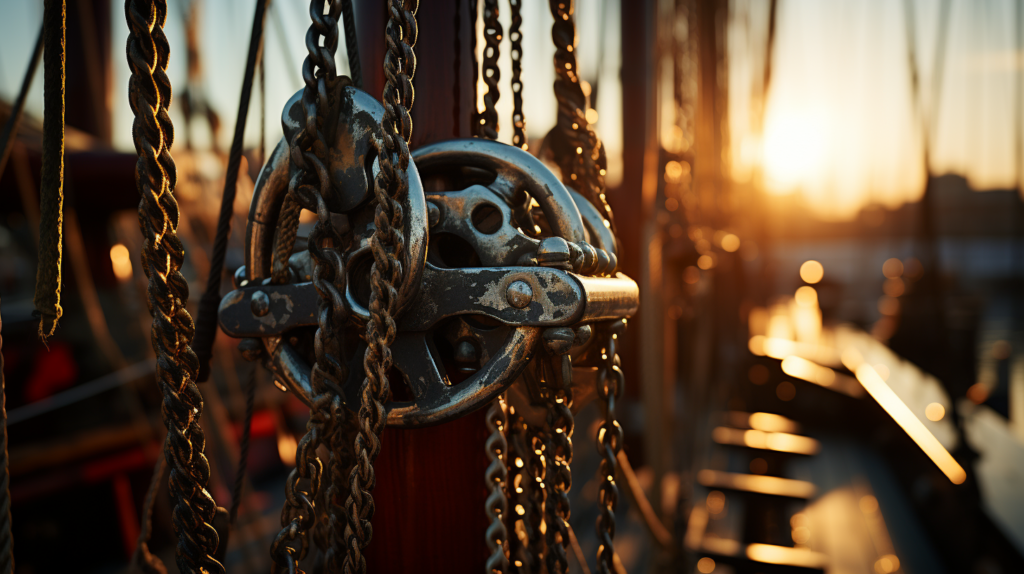Table of Contents
Table of Contents

Navigating the wide world of sailboat rigging hardware can be a daunting task, even for seasoned sailors. Did you know that the right rigging hardware is crucial to secure your sails and maintain boat stability? This article will guide you through the different types of sailboat rigging hardware, demonstrating their roles and importance in safe and efficient sailing.
Dive in to unlock your full potential as a sailor.
Key Takeaways
- Stainless steel wire rope, such as the 1×19 and 7×19 configurations, is durable and ideal for different sailing applications.
- Clevis pins provide stability and flexibility in sailboat rigging systems.
- Turnbuckles like a jaw to swage, jaw-to-jaw, and T-bar are essential for adjusting sail tension.
- Toggle jaws and toggles offer versatility in rigging setups.
Common Types of Sailboat Rigging Hardware
 Stainless steel wire rope is a popular type of sailboat rigging hardware, available in 1×19 and 7×19 configurations. Nicopress oval compression sleeves are also commonly used to secure wire rope.
Stainless steel wire rope is a popular type of sailboat rigging hardware, available in 1×19 and 7×19 configurations. Nicopress oval compression sleeves are also commonly used to secure wire rope.
Sailboats often rely on clevis pins for various applications, while turnbuckles (such as jaw-to-swage, jaw-to-jaw, and T-bar) provide adjustable tension. Toggle jaws and toggles, like threaded eye rods and T-bars, offer additional versatility in rigging setups.
Stainless Steel Wire Rope (1×19 and 7×19)
Stainless steel wire rope is a popular choice for sailboat rigging because of its durability and strength. Two types, 1×19 and 7×19, are commonly used in sailing applications. The 1×19 stainless steel wire rope consists of nineteen strands twisted together to form a single cable.
This configuration provides high tensile strength while also maintaining relatively low flexibility, making it ideal for straight-line standing rigging like backstays and forestays.
On the other hand, the 7×19 stainless steel wire rope includes seven groups of nineteen wires each woven together into one cable which offers more flexibility than the 1×19 type thus proving beneficial for running rigging or any application where repeated bending is involved.
Both these stainless steel wire ropes resist corrosion and hold up well under harsh marine conditions enhancing overall boat performance while ensuring safety at sea.
Nicopress Oval Compression Sleeves
Nicopress Oval Compression Sleeves play a pivotal role in sailboat rigging hardware. They provide firm, secure connections between steel wire ropes and other rigging components. Crafted from high-strength copper alloys, these sleeves ensure an almost indestructible bond when used in conjunction with a proper crimping tool.
These power-packed little tools offer increased stability and strength to your sailboats’ standing and running rigging systems. Whether you’re dealing with control lines or supporting the mast upright, Nicopress Oval Compression Sleeves come into action ensuring a safe and efficient sailing experience.
No matter how hard the wind blows or waves crash, you can trust these sleeves to maintain their hold firmly.
Clevis Pins
Clevis pins hold a significant place in the sailboat rigging hardware lineup. These simple yet exceptionally strong pieces are commonly used to connect the different parts of the rigging system.
The design includes a cylindrical body with a hole at one end where you’d insert a cotter pin for secure fastening. Ranging in various sizes, Clevis pins play an essential role in maintaining stability and offering flexibility during maneuvers.
They’re typically made from corrosion-resistant materials like stainless steel, ensuring durability even under harsh marine conditions. You’d often find them employed within toggle assemblies, shackles, chain plates, and numerous other places where removable pins are necessary on your sailboat’s standing rigging system.
Turnbuckles (Jaw to Swage, Jaw to Jaw, T-Bar, etc.)
Turnbuckles are a type of sailboat rigging hardware that plays a crucial role in adjusting the tension of your sails. They come in different configurations, such as jaw-to-swage, jaw-to-jaw, and T-bar.
These turnbuckles allow you to easily tighten or loosen the rigging wires, which helps control the shape and performance of your sails. The jaw-to-swage turnbuckle connects the wire rope to a fitting with a threaded stud on one end and a swage-fitting on the other end.
Jaw-to-jaw turnbuckles have two threaded studs with jaws that grip onto fittings at each end. T-bar turnbuckles feature a center section shaped like a “T” and provide easy adjustment using pins or bolts.
Toggle Jaws and Toggles (Threaded Eye Rods, T-Bars, etc.)
Toggle jaws and toggles are important sailboat rigging hardware components that provide connection points for various rigging elements. They are commonly used in conjunction with threaded eye rods, T-bars, and other fittings.
These toggle jaws and toggles allow for flexibility and easy adjustment of the rigging system, ensuring proper tensioning of the sails. With their sturdy construction and reliable performance, toggle jaws and toggles play a crucial role in maintaining the stability and efficiency of a sailboat’s rigging setup.
Essential Sailboat Rigging Accessories

Thimbles and heavy-duty thimbles are crucial for protecting the eye of a wire rope and preventing wear and tear.
Thimbles and Heavy-Duty Thimbles
Thimbles and heavy-duty thimbles are essential sailboat rigging accessories that play a crucial role in protecting ropes from wear and tear. Thimbles are small metal devices that are inserted into the loop of a rope to prevent it from being crushed or damaged by contact with other surfaces.
Heavy-duty thimbles, as the name suggests, provide even greater durability and strength for more demanding sailing conditions. These rugged thimbles offer extra protection against abrasion and help extend the lifespan of your rigging equipment.
Whether you’re racing or cruising, investing in quality thimbles is key to maintaining the integrity of your sailboat’s rigging system.
Rigging Tape
Rigging tape is an essential accessory for sailboat rigging. It helps protect and secure various components, such as wire rope terminations and fittings. Made from durable materials, rigging tape provides a strong hold and resists moisture, UV rays, and saltwater corrosion.
With its self-fusing properties, it creates a tight seal that prevents water penetration and minimizes wear on the rigging hardware. Whether you need to wrap a stay adjuster or reinforce a clevis pin connection, rigging tape is your go-to solution for keeping your sailboat’s rigging in top condition.
Cotter Pins
Cotter pins are small, durable pieces of sailboat rigging hardware that play an important role in keeping things securely fastened. These pins are often used to secure clevis pins and other types of fasteners, preventing them from loosening or falling out while sailing.
Made from stainless steel or other sturdy materials, cotter pins provide a reliable and easy-to-use solution for ensuring the safety and stability of various rigging components on a sailboat.
Whether you’re replacing old cotter pins or adding new ones to your rigging system, these simple yet essential pieces of hardware are a must-have for any sailor looking to maintain the integrity of their boat’s rigging.
Stay Adjusters
Stay adjusters are an important type of sailboat rigging hardware that sailors rely on to maintain proper tension in their stays. These adjustable devices are used to tighten or loosen the stays, which are the lines or cables that support the mast and keep it upright.
Stay adjusters allow sailors to make precise adjustments based on wind conditions and sailing performance. By ensuring that the stays have the correct tension, stay adjusters help optimize a sailboat’s stability and overall performance on the water.
Whether you’re racing or cruising, having reliable stay adjusters is crucial for safe and efficient sailing.
Quick Release Levers and Pins
Quick-release levers and pins are essential sailboat rigging accessories that provide convenience and efficiency. These hardware components allow sailors to quickly and easily adjust or remove certain parts of the rigging system, such as boom vangs or backstays, without the need for tools.
Quick-release levers are designed with a simple locking mechanism that can be easily manipulated by hand, while quick-release pins have a spring-loaded ball bearing that secures them in place until released.
With these handy devices, sailors can make on-the-fly adjustments during races or quickly disassemble their rigging when needed.
Specialty Sailboat Rigging Hardware
Specialty sailboat rigging hardware includes machine swage forks and studs, hi-mod compression studs, and eye fittings, double jaw toggles, halyards, and blocks.
Machine Swage Forks and Studs
Machine swage forks and studs are important components of sailboat rigging hardware. These fittings are used for connecting wire ropes to other parts of the rigging system, such as turnbuckles or toggles.
Machine swaging is a process that involves mechanically crimping the fitting onto the wire rope using specialized equipment. This ensures a secure and strong connection between the two.
Machine swage forks have forked ends that can be attached to turnbuckle bodies, while machine swage studs have threaded ends that can be screwed into toggle jaws or other fittings.
Hi-Mod Compression Studs and Eye Fittings
Hi-Mod compression studs and eye fittings are specialized sailboat rigging hardware that plays a vital role in maintaining the integrity of the standing rigging system. These high-quality fittings are designed to provide exceptional strength and durability, ensuring that your mast stays securely in place even under strong winds and rough conditions.
Made from premium materials such as stainless steel, Hi-Mod compression studs, and eye fittings offer superior corrosion resistance, making them perfect for marine environments. With their precise engineering and reliable performance, these fittings are an essential choice for sailors who prioritize safety and reliability in their rigging systems.
Double Jaw Toggles
Double jaw toggles are an important type of sailboat rigging hardware that plays a crucial role in connecting various parts of the rigging system. These toggles feature two jaws, which can be securely fastened to different components such as turnbuckles or threaded eye rods.
The double jaw design provides increased strength and stability, ensuring that the rigging remains secure even under heavy loads and extreme conditions. Sailors rely on double jaw toggles to maintain the integrity of their sailboat’s rigging system, allowing for safe and efficient sailing experiences.
Halyards and Blocks
Halyards and blocks are essential sailboat rigging hardware used to control the hoisting and lowering of sails. Halyards are ropes or lines that raise and lower the sails, while blocks are pulleys that help guide and redirect the halyard lines.
These components work together to allow sailors to adjust the position of their sails, enabling them to catch different wind angles for optimal performance. Halyards and blocks come in various sizes and materials, such as stainless steel or high-strength synthetic fibers, ensuring durability against strong winds and rough conditions on the water.
Where to Find Sailboat Rigging Hardware
You can find sailboat rigging hardware at online retailers, specialty marine stores, and local boatyards and rigging professionals. Explore these options to find the perfect hardware for your sailboat needs.
Online retailers
There are several online retailers where sailors can find a wide range of sailboat rigging hardware. Here are some options to consider:
- West Marine: A popular online retailer that offers a variety of sailboat rigging hardware, including wire ropes, compression sleeves, clevis pins, turnbuckles, toggle jaws, and more.
- Defender Marine: This online store is known for its extensive selection of sailboat rigging accessories like thimbles, rigging tape, cotter pins, stay adjusters, and quick-release levers.
- Fisheries Supply: Another reliable online retailer that carries a comprehensive range of specialty sailboats rigging hardware such as machine swage forks and studs, hi-mod compression studs and eye fittings, double jaw toggles, halyards, and blocks.
- Amazon: With its vast inventory of products from various sellers, Amazon is a convenient option for sailors looking for sailboat rigging hardware.
- Sailrite: This online store specializes in DIY sailing projects and offers a variety of sailboat rigging hardware suitable for both small boats and larger vessels.
Specialty marine stores
Specialty marine stores offer a wide range of sailboat rigging hardware for sailors to choose from. These stores are dedicated to providing high-quality and specialized equipment for all types of sailboats. They have knowledgeable staff who can help sailors select the right hardware for their specific needs. In these stores, you can find a variety of rigging hardware, including stainless steel wire ropes, compression sleeves, clevis pins, turnbuckles, toggle jaws, and more. With their expertise and extensive selection, specialty marine stores are the go-to place for sailors looking for top-notch sailboat rigging hardware.
Local boatyards and rigging professionals.
Local boatyards and rigging professionals can be valuable resources for finding sailboat rigging hardware. They have the expertise to assess your specific needs and help you choose the right hardware for your sailboat. Additionally, they often have a wide range of rigging accessories in stock, making it easy to find what you need. Whether you’re looking for stainless steel wire rope, turnbuckles, or any other type of rigging hardware, local boatyards and rigging professionals are a convenient and reliable option.
Conclusion
In conclusion, understanding the different types of sailboat rigging hardware is essential for any sailor. From stainless steel wire rope to clevis pins and turnbuckles, each piece plays a crucial role in supporting the sails and controlling the rigging.
Whether you’re looking for specialty hardware or essentials like thimbles and rigging tape, knowing where to find these items will ensure safe and efficient sailing. So gear up with the right equipment and set sail confidently on your next adventure!
FAQs
1. What is sailboat rigging?
Sailboat rigging refers to the various components, systems, and hardware used to support and control the sails on a sailboat. It includes the mast, boom, rigging wires, halyards, sheets, blocks, and other fittings that enable the sails to be raised, lowered, trimmed, and controlled.
2. What are some common sailboat rigging terms?
Common sailboat rigging terms include sailboat hardware, cleat, winch, marine hardware, sailing hardware, hull, tiller, deck hardware, stern, traveler, splice, rudder, dinghy, spar, mainsheet, furling systems, lifeline, and cockpit.
3. What is the purpose of sailboat hardware?
Sailboat hardware refers to the various fittings and components used to secure and control the sails, rigging, and other equipment on a sailboat. This includes items such as cleats, winches, blocks, tracks, track cars, and more. Sailboat hardware plays a critical role in adjusting sail shape, controlling sail trim, and maintaining the overall performance and safety of the sailboat.
4. What are the different types of sailboat rigging hardware?
There are several types of sailboat rigging hardware such as standing rigging, RC sailboat rigging, and model sailboat rigging.
5. Can I find a diagram for all types of sailboat rigs?
Yes, you can find diagrams that show different types of rigs like small sailboat rigging to help you understand how to properly rig boats.
6. How do the various pieces of sailboat standing rigging hardware get their names?
The names for different pieces of sailing boat’s rigged equipment often come from their function or shape to the overall setup or structure.
7. Is it possible to use one type of hardware for all my boat’s sails?
While some components may serve similar functions in various types, each type of boat harness has unique designs and features suited best for specific purposes and conditions on water bodies.
8. Where can I get valuable information about small sailboats’ mast configurations and accessory items?
You can learn about all sorts from relevant literature about the subject matter or even online resources that discuss aspects like preparing an efficient RC rigged vessel or understanding your craft better with descriptive diagrams showcasing every feature.
9. What factors should I consider when choosing the best line for sailboat rigging?
When selecting the best line for your sailboat rigging, you should consider factors such as the type of sailboat you own, the intended purpose of the line, load requirements, material durability, and the sailing conditions you typically encounter.
10. What is the difference between standing rigging and running rigging?
Standing rigging refers to the permanent rigging on a sailboat that supports the mast, such as shrouds and stays. Running rigging, on the other hand, includes lines that are used for controlling sails, such as halyards and sheets.
11. What are the advantages of using stainless steel wire rope for sailboat rigging?
Stainless steel wire rope offers excellent strength, corrosion resistance, and durability, making it a popular choice for sailboat rigging. It can withstand harsh marine environments and is less likely to stretch or deform under high loads.
12. Can I use other materials like nylon or synthetic ropes for sailboat rigging?
While nylon ropes are commonly used for running rigging due to their elasticity and shock-absorbing properties, they are not suitable for standing rigging as they lack the strength and resistance to stretch over time. It is recommended to use stainless steel wire ropes or other suitable materials specifically designed for sailboat rigging.
13. What are some popular brands for sailboat rigging hardware?
There are several popular brands known for their high-quality sailboat rigging hardware, including Harken, Ronstan, and Sparcraft. These brands offer a wide range of rigging hardware options to suit various sailboat types and rigging needs.
14. How often should I replace my sailboat rigging?
It is important to regularly inspect your sailboat rigging for signs of wear, corrosion, or damage. The frequency of replacement will depend on various factors such as usage, sailing conditions, and the materials used. As a general guideline, it is recommended to replace standing rigging every 10-15 years, or sooner if significant wear or damage is detected.
15. What are some common types of sailboat rigging fittings?
Common sailboat rigging fittings include turnbuckles, thimbles, eye straps, swages, and wire rope clips. These fittings are used to connect and tension the various components of the rigging system securely.
16. How do cleats work in sailboat rigging?
A cleat is a device used to secure lines (ropes) in place on a sailboat. It has two horns or jaws that allow the line to be easily inserted but prevent it from slipping out unintentionally. To use a cleat, the line is simply wrapped around one horn, then crossed over and wrapped around the other horn several times. This creates friction and holds the line securely in place.
17. What is the purpose of winches in sailboat rigging?
Winches are mechanical devices used to increase the mechanical advantage when handling heavy loads, such as raising sails or trimming sheets. They have a drum that the line is wrapped around, and a handle or crank that is used to rotate the drum. By turning the handle, the winch provides extra power and leverage, making it easier to control the tension and position of the line.
18. How does the traveler system work in sailboat rigging?
The traveler system on a sailboat is a track and car arrangement that allows for the adjustment of the mainsheet’s attachment point along the boat’s cockpit. By moving the traveler’s car to different positions, the angle of the mainsheet can be changed, which affects the sail’s trim and overall performance. This allows the sailor to optimize sail control and balance the boat.

